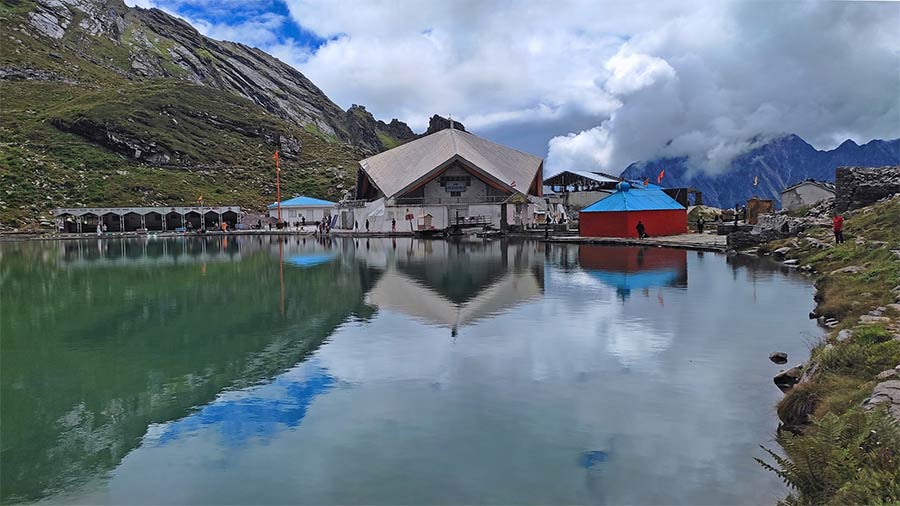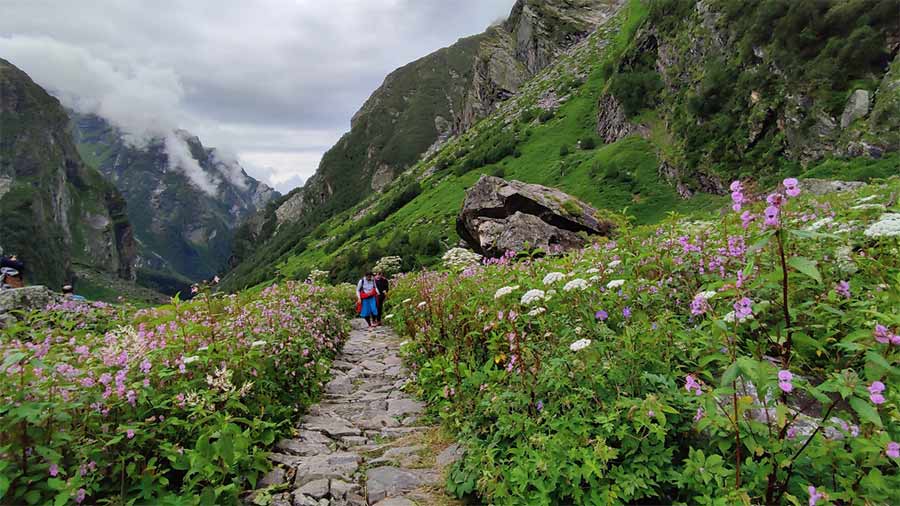After the successful completion of the Valley of Flowers trek, we prepared ourselves for the more daunting trek of Gurudwara Shri Hemkunt Sahib. The trek route was much longer than Valley of Flowers. It takes around 5-6 hours to reach the Gurudwara by trek route from Ghangaria. Since the holy place closes by 2pm; it is advisable to start as early as possible. Though we started at 6am, the ideal time to start is 4am.
History of Gurudwara Shri Hemkunt Sahib
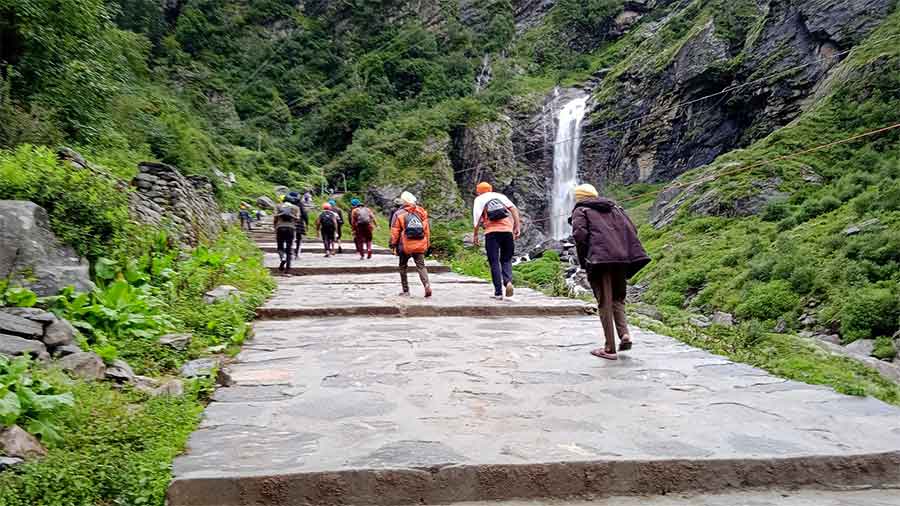
A group of Sikh pilgrims starting the Hemkunt Sahib trek from Ghangaria
Located at an altitude of approximately 4,330mt (14,206 feet), Gurudwara Shri Hemkunt Sahib is a Sikh place of worship and pilgrimage site in Chamoli district of Uttarakhand. It is considered to be the place of meditation of Guru Gobind Singh, the 10th Guru.
The verses written in Gurmukhi by Guru Gobind Singh were compiled as Dasam Granth. Here, we find the mention of “Hemkunt” for the first time in a narrative named Bachitra Natak (the astounding drama).
Based on a book written by eminent Punjabi historian Bhai Veer Singh, Sant Sohan Singh, a retired granthi from the Indian Army went on a quest to locate the meditation place of Guru Gobind and came to know about a place named Lokpal, where local pilgrims visited regularly. On visiting this place, Sant Sohan Singh found the geographical details of the place similar to the description given by Guru Gobind Singh. Sohan Singh also experienced a vision, which led him to conclude that Lokpal was actually Hemkunt – the meditation place of Guru Gobind Singh.
A gurudwara, measuring 10 feet by 10 feet, was completed by November 1935. Design and construction of the present Gurudwara at Hemkunt started in the mid-1960s. Architect Manmohan Singh Siali of the Military Engineering Services designed the layout of the present Gurudwara.
Trek to Hemkunt Sahib

The valley is lush green in monsoon
The route to the Gurudwara is constantly uphill, which makes it difficult to embark on this journey. There are many places to stop on the route, where one can have a bite or sip some tea or cold drinks. It started drizzling in the morning, so we put on our rain gears. Many Sikh pilgrims marched past us. I was amazed to see many of them wearing only slippers and walking at a brisk pace. On the other hand, I could see many embarking the journey on ponies, or carried by porters.
Walking uphill continuously is a strenuous task and it is best to walk at a moderate pace to have some energy left when you reach the top. Fog and mist was covering the area now and then. The rain slowed down and finally stopped.
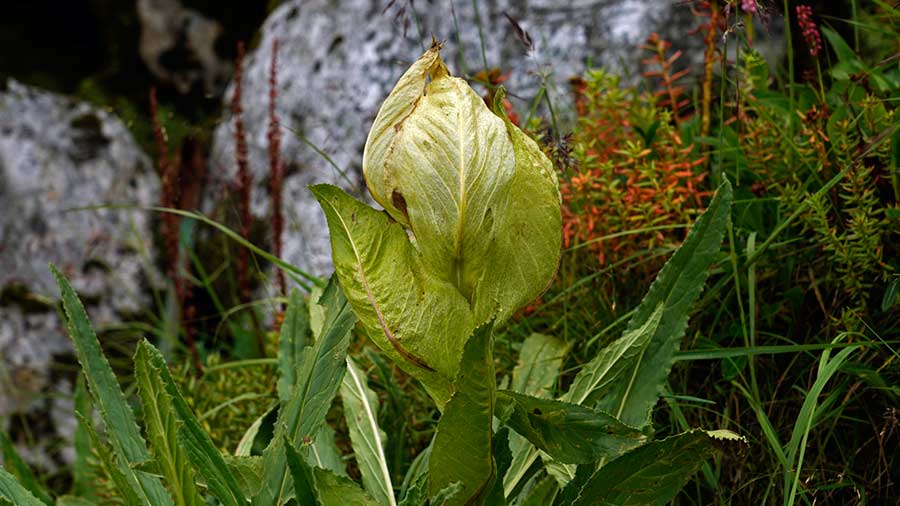
A Bramha Kamal on the way to Hemkunt Sahib
Around 10am, my trek partner Amit spotted the first blue poppy flower. Further uphill, we spotted many of them. My eyes were eagerly looking for the Brahma Kamal – a flower often found on this route. The trek route is a birdwatcher’s paradise too, and I spotted a pink-browed rosefinch at very close range.
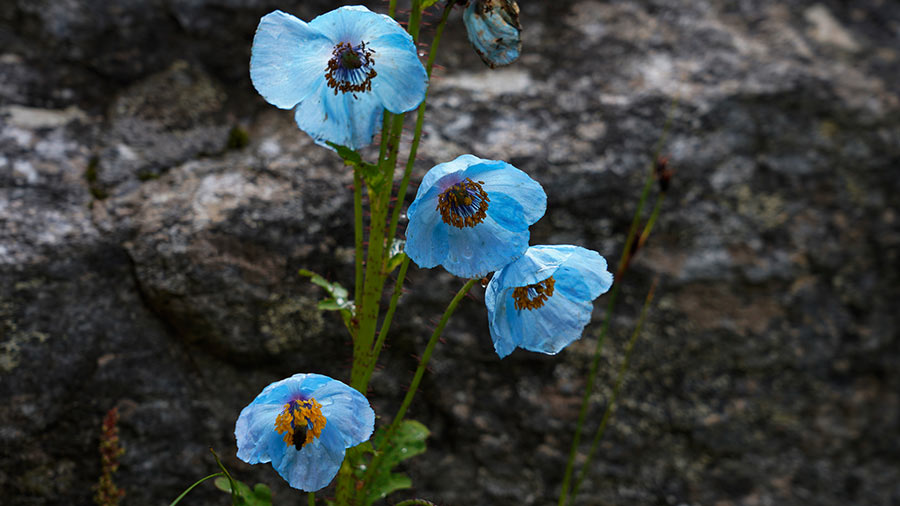
Blue Poppy flowers
We crossed some ice patches and came to a steep pathway beside a waterfall, which was a short-cut route to the Gurudwara. This last bit of climb almost took our breath away. The view which we usually see of Hemkunt Sahib in magazines or posters with a lake in the foreground is not what you see after reaching your destination here. You first reach in front of the Gurudwara. To behold that classic scene, you have to take the path beyond the Gurdwara which passes by a temple dedicated to Laxmana to the banks of the lake. To get a top view you need to go a bit uphill again on the other side of the Gurudwara. We reached our destination at 12:30pm.
Scene inside the Gurudwara

First view of Gurudwara Hemkunt Sahib as it appears after reaching the place
At the entry gate of the premises of Gurudwara Shri Hemkunt Sahib, you will be provided with a piece of coloured cloth to cover your forehead. We entered inside the two-storied Gurudwara, whose architecture itself is a marvel. On the top floor there is an assembly hall, where people sit and listen to prayers. We took a stroll on the top floor, where we were served one of the best halwas I had ever tasted. Later, we got to taste the khichdi too at the the Langar along with a cup of tea. In the morning, people take baths in the lake.
We left the place by 1.30pm. I spotted a few Brahma Kamals on our way back, much down on the side of the pathway. There was no path to reach there, but I somehow managed to reach near the flowers and took some great shots.
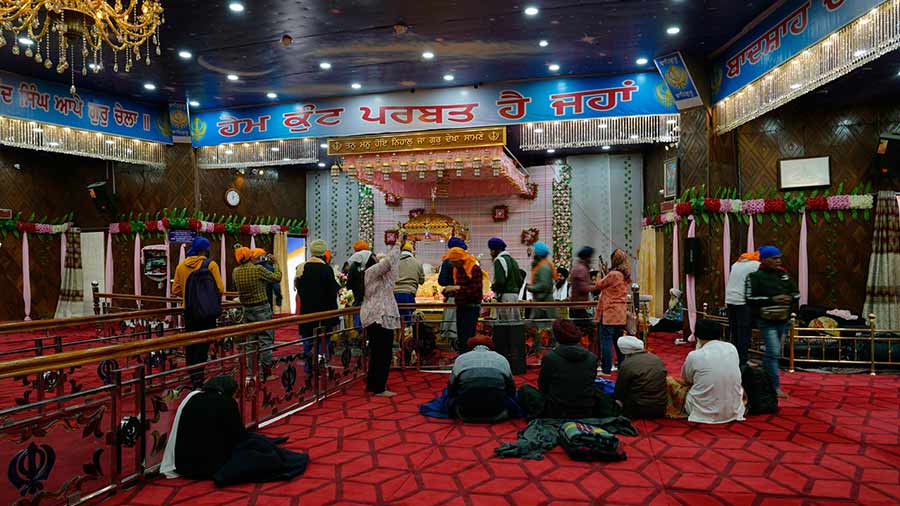
Interiors of Gurudwara Hemkunt Sahib
The downhill journey was uneventful. We stopped midway for some food and reached Ghangaria at about 6.30pm in the evening.
Amit was extremely tired after the trek and I knew it would be very strenuous for him to trek back the 13km back to Govindghat the next day. So we took a helicopter ride early in the morning from the helipad at Ghangaria and reached Govindghat by 8.30 in the morning. The 10-minute ride was memorable and fascinating.

A helicopter on its way to Govindghat from Ghangaria
I plan to return to Gurduwara Shri Hemkunt Sahib again in winter some time when part of the lake gets frozen. Meanwhile, I received the news that soon a ropeway will be built to reach Hemkunt from Ghangaria.
Travel tips
- For the Hemkunt Sahib trek in August, it is essential to carry a poncho as it is the monsoon season. High ankle trekking shoes, walking sticks, warm clothes and windcheaters are essential.
- Start at least by 6am so that you have some time after reaching your destination. The Gurudwara closes at 2 pm.
- Food available on the trek route is expensive. It is better to carry your own food.
- Helicopters book people on a first come, first served basis. However, your body weight determines how fast you will be accommodated in the helicopter.
